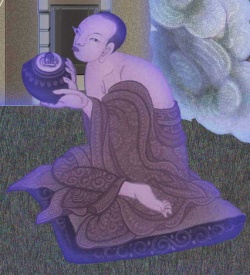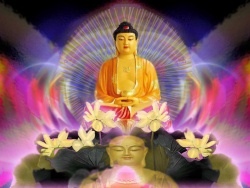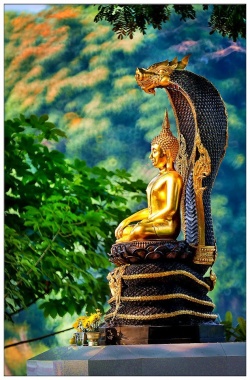Difference between revisions of "28 Buddhas"
| (3 intermediate revisions by the same user not shown) | |||
| Line 1: | Line 1: | ||
| − | <nomobile>{{DisplayImages|1813|4323|4054 | + | <nomobile>{{DisplayImages|1813|4323|4054}}</nomobile> |
| Line 18: | Line 18: | ||
All of the [[trees]] are considered [[Bodhi Trees]] but they were not all the same {{Wiki|species}} of [[tree]]. | All of the [[trees]] are considered [[Bodhi Trees]] but they were not all the same {{Wiki|species}} of [[tree]]. | ||
| + | |||
| + | |||
| + | |||
| + | In [[Theravada Buddhism]], '[[Buddha]]' refers to one who has become [[enlightened]] through their [[own]] efforts and [[insight]]. A [[Buddha]] is someone who has [[realized]] the [[enlightenment]] that ends the [[cycle of birth and death]] and which brings [[liberation]] from [[suffering]]. In the [[Pali canon]], it is stated that [[Buddhas]] have appeared in the {{Wiki|past}} and will also appear in the {{Wiki|future}}. | ||
| + | |||
| + | |||
| + | There were also numerous [[enlightened]] [[Buddhas]] who arose in earlier world-cycles and who [[preached]] the very same [[Dhamma]] that gives [[deliverance]] from [[suffering]] and [[death]] to all mature [[beings]]. The names of these [[28 Buddhas]] are religiously preserved by [[Buddhists]], together with their age, their stature, the names of the [[trees]] under which they obtained | ||
| + | |||
| + | [[Enlightenment]], their country, and the names of their father and mother. They all have two chief [[disciples]] to assist them in their [[mission]]. Every [[Buddha]] has always obtained the supreme [[intelligence]] under the shadow of a certain [[tree]]. | ||
| + | |||
| + | |||
| + | These [[28 Buddhas]] are: [[Taṇhaṅkara Buddha]], [[Medhaṅkara Buddha]], [[Saraṇkara Buddha]], [[Dīpankara Buddha]], [[Koṇdañña Buddha]], [[Maṅgala Buddha]], [[Sumana Buddha]], [[Revata Buddha]], [[Sobhita Buddha]], [[Anomadassi Buddha]], [[Paduma Buddha]], [[Nārada Buddha]], [[Padumuttara Buddha]], [[Sumedha Buddha]], [[Sujāta Buddha]], [[Piyadassi Buddha]], [[Atthadassi Buddha]], [[Dhammadassī Buddha]], [[Siddhattha Buddha]], [[Tissa Buddha]], [[Phussa Buddha]], [[Vipassī Buddha]], [[Sikhī Buddha]], [[Vessabhū Buddha]], [[Kakusandha Buddha]], [[Koṇāgamana Buddha]], [[Kassapa Buddha]], ending with [[Gautama Buddha]]. Presented below are illustrations of some of these [[28 Buddhas]] from [[Burmese]] [[manuscripts]]. | ||
| + | |||
| + | The [[Buddha lineage]] begins with a [[Buddha]] called [[Taṇhaṅkara]]. [[Taṇhaṅkara Buddha]] was born as a son of [[King]] [[Sunandha]] and [[Queen Sunandha]] in the city of Puppavadī. He [[attained]] [[Enlightenment]] under a [[Rukkaththana]] [[tree]]. [[Taṇhaṅkara Buddha]], [[Medhaṅkara Buddha]], [[Saraṇkara Buddha]] and [[Dīpankara Buddha]] were born in the same [[aeon]] ([[kalpa]]). | ||
| + | |||
| + | |||
| + | [[Dīpaṅkara Buddha]] was born as a son of [[King]] [[Sudeva]] and [[Queen Sumedhā]] in the city of Rāmāvatī. {{Wiki|Prince}} [[Dīpaṅkara]] [[married]] {{Wiki|princess}} [[Paduma]] and had a son named Usabhakkhandā. He [[attained]] [[Enlightenment]] under a [[Pipphali tree]]. He [[preached]] his [[first sermon]] at Nandarāma at Sirighara. Sumaṅgala and [[Tissa]] were his chief [[disciples]]. He gave [[niyatha vivarana]] ({{Wiki|prediction}} of {{Wiki|future}} [[Buddhahood]]) to the [[Ascetic]] [[Sumedha]]. | ||
| + | |||
| + | |||
| + | Bodhisitta [[Sumedha]] was born as a son to a [[Brahmin]] [[family]] in the city of [[Amaravati]]. After the [[death]] of his [[parents]] he [[thought]] about how his [[parents]] were not able to take their [[wealth]] with them beyond [[death]]. Therefore [[Sumedha]] gave away his [[wealth]] in [[alms]] in order to obtain the [[merit]] of the [[deeds]], which could follow him after [[death]]. Then he went to the [[forest]] to become a [[hermit]] to seek [[merit]]. When [[Dipankara Buddha]] (a [[Buddha]] who had reached [[enlightenment]] [[aeons]] before [[Gautama]], the [[historical Buddha]]) followed by His | ||
| + | |||
| + | |||
| + | [[disciples]] came to the city of [[Ramma]], [[people]] were cleaning the road on which he would walk. [[Sumeda]] took {{Wiki|responsibility}} for one part of the muddy road, but he was unable to finish the work by the time the [[Buddha]] arrived, and the road was still full of mud. He therefore laid himself down on the road for the [[Buddha]] to walk upon. [[Dīpankara Buddha]] foretold that [[Sumedha]] would become a [[Buddha]] named [[Gautama]] in the ages of the {{Wiki|future}}. | ||
| + | |||
| + | |||
| + | After [[Dīpankara]], [[Koṇdañña]] was born. The [[kalpas]] ([[aeons]]) that passed between the time of [[Dīpankara]] and [[Koṇdañña]] were countless. [[Buddhas]] [[Maṅgala]], [[Sumana]], [[Revata]] and [[Sobhita]] were born in the same [[kalpa]]. [[Anomadassi]], [[Paduma]], [[Nārada]] were born in the same [[kalpa]]. The [[kalpas]] which passed between [[Nārada]] and [[Padumuttara]] were also countless. [[Sumedha]], [[Sujāta]], [[Piyadassi]], [[Atthadassi]] and [[Dhammadassī]] were born in the same [[kalpa]]. After [[Dhammadassī]], [[Siddhattha]], [[Tissa]], [[Phussa]],[[Vipassī]], [[Sikhī]] and [[Vessabhū]] were born. | ||
| + | |||
| + | |||
| + | [[Gautama]] [[Buddha’s]] predecessors in the {{Wiki|present}} world-cycle were [[Kakusandha]], [[Koṇāgamana]] and [[Kassapa]]. These [[four Buddhas]] have already performed their great task. According to [[Buddhist scripture]], [[Metteyya]] will be a successor of [[Gautama]] who will appear on [[Earth]], [[attain enlightenment]], and teach [[Dhamma]]. | ||
| + | |||
| + | |||
| + | [[Gautama Buddha]] is [[the fourth]] and current [[Buddha of the present]] [[kalpa]]. He was born as a son of [[King Suddhodana]] and [[Queen Mahamaya]] in the city of [[Kapilavatthu]]. {{Wiki|Prince}} [[Siddhatta]] [[Gautama]] [[married]] {{Wiki|princess}} [[Yasodhayā]] and had a son named [[Rāhula]]. {{Wiki|Prince}} [[Siddhatta]] finally arose fully [[enlightened]] as [[Gautama Buddha]] under the shade of the [[Peepal]] [[Bodhi tree]] which grew up spontaneously at the very [[moment]] he was born. [[Kolita]] and [[Upatissa]] were his chief [[disciples]] to assist him in his [[mission]]. He delivered his [[first sermon]] | ||
| + | |||
| + | |||
| + | [[Dhammacakkappavattana Sutta]] in a [[deer park]] at [[Benares]]. The [[Buddha]] spent the rest of his [[life]] [[teaching]] [[Dhamma]] (the [[path of righteousness]]). His [[teaching]] was quite {{Wiki|practical}}, as he never [[taught]] what he himself had not seen and known. In his eightieth year when he was in [[Kusinara]], he had a severe attack of dysentery. [[Buddha]] consoled [[Ananda]] who was weeping, and then called his [[disciples]] together and addressed them to work on their {{Wiki|salvation}} with [[diligence]]. Then he entered [[Parinirvana]], from which there is no return. | ||
| + | |||
| + | |||
| + | All these [[28 Buddhas]] were born into {{Wiki|royal}} families or rich [[Brahmin]] families. When they had seen the [[four signs]] - an old man, a sick man, a corpse, and an [[ascetic]] - they renounced [[worldly life]] and left home. They engaged in [[meditation]] on [[mindfulness]] until they [[attained]] [[Enlightenment]]. At the request of [[God]] [[Brahma]], they [[preached]] their [[first sermon]] to those who followed them. | ||
| + | |||
| + | The [[auspicious]] {{Wiki|ceremony}} of [[Buddha]] [[Puja]] is held to pay homage to the [[28 Buddhas]] who were [[enlightened]] and who [[taught]] [[Dhamma]] in different times. This practice is to remind [[Buddhists]] to strengthen their [[devotion]], and many [[Buddhists]] also pay homage to the [[future Buddha]], [[Metteyya]]. | ||
| + | |||
| + | |||
| + | |||
See: [[Bodhi Tree]] for the complete list of the [[trees]] for each [[Buddha]]. | See: [[Bodhi Tree]] for the complete list of the [[trees]] for each [[Buddha]]. | ||
| Line 58: | Line 101: | ||
{{R}} | {{R}} | ||
http://www.dhammawiki.com/index.php?title=28_Buddhas | http://www.dhammawiki.com/index.php?title=28_Buddhas | ||
| + | [[Category:Buddhist Terms]] | ||
[[Category:List of the Buddhas]] | [[Category:List of the Buddhas]] | ||
| + | [[Category:Buddhism]] | ||
| + | [[Category:Tibetan Buddhism]] | ||
| + | [[Category:Deities]] | ||
Latest revision as of 15:18, 9 May 2023
There have been 28 samma-sam-buddhas (teaching Buddhas who rediscover the Dhamma and teach the masses when the Dhamma has died-out), ending in the historical Buddha of our time. The Buddha was not the first Buddha, nor the last.
In most Theravada countries it is the custom for Buddhists to hold elaborate festivals to honor 28 Buddhas.
For example, in various parts of Myanmar, festivals are held to pay homage to 28 Buddhas, especially in the fair weather season.
The twenty eight Buddhas are said to have attained enlightenment from the time Gotama Buddha attained his first definite prophecy (assurance that one will definitely become a Buddha one day) from Dipankara Buddha.
According to most Buddhist traditions, Metteyya (Maitreya, in Sanskrit) is expected to be the next Buddha.
Each Buddha attained enlightenment meditating under a tree.
All of the trees are considered Bodhi Trees but they were not all the same species of tree.
In Theravada Buddhism, 'Buddha' refers to one who has become enlightened through their own efforts and insight. A Buddha is someone who has realized the enlightenment that ends the cycle of birth and death and which brings liberation from suffering. In the Pali canon, it is stated that Buddhas have appeared in the past and will also appear in the future.
There were also numerous enlightened Buddhas who arose in earlier world-cycles and who preached the very same Dhamma that gives deliverance from suffering and death to all mature beings. The names of these 28 Buddhas are religiously preserved by Buddhists, together with their age, their stature, the names of the trees under which they obtained
Enlightenment, their country, and the names of their father and mother. They all have two chief disciples to assist them in their mission. Every Buddha has always obtained the supreme intelligence under the shadow of a certain tree.
These 28 Buddhas are: Taṇhaṅkara Buddha, Medhaṅkara Buddha, Saraṇkara Buddha, Dīpankara Buddha, Koṇdañña Buddha, Maṅgala Buddha, Sumana Buddha, Revata Buddha, Sobhita Buddha, Anomadassi Buddha, Paduma Buddha, Nārada Buddha, Padumuttara Buddha, Sumedha Buddha, Sujāta Buddha, Piyadassi Buddha, Atthadassi Buddha, Dhammadassī Buddha, Siddhattha Buddha, Tissa Buddha, Phussa Buddha, Vipassī Buddha, Sikhī Buddha, Vessabhū Buddha, Kakusandha Buddha, Koṇāgamana Buddha, Kassapa Buddha, ending with Gautama Buddha. Presented below are illustrations of some of these 28 Buddhas from Burmese manuscripts.
The Buddha lineage begins with a Buddha called Taṇhaṅkara. Taṇhaṅkara Buddha was born as a son of King Sunandha and Queen Sunandha in the city of Puppavadī. He attained Enlightenment under a Rukkaththana tree. Taṇhaṅkara Buddha, Medhaṅkara Buddha, Saraṇkara Buddha and Dīpankara Buddha were born in the same aeon (kalpa).
Dīpaṅkara Buddha was born as a son of King Sudeva and Queen Sumedhā in the city of Rāmāvatī. Prince Dīpaṅkara married princess Paduma and had a son named Usabhakkhandā. He attained Enlightenment under a Pipphali tree. He preached his first sermon at Nandarāma at Sirighara. Sumaṅgala and Tissa were his chief disciples. He gave niyatha vivarana (prediction of future Buddhahood) to the Ascetic Sumedha.
Bodhisitta Sumedha was born as a son to a Brahmin family in the city of Amaravati. After the death of his parents he thought about how his parents were not able to take their wealth with them beyond death. Therefore Sumedha gave away his wealth in alms in order to obtain the merit of the deeds, which could follow him after death. Then he went to the forest to become a hermit to seek merit. When Dipankara Buddha (a Buddha who had reached enlightenment aeons before Gautama, the historical Buddha) followed by His
disciples came to the city of Ramma, people were cleaning the road on which he would walk. Sumeda took responsibility for one part of the muddy road, but he was unable to finish the work by the time the Buddha arrived, and the road was still full of mud. He therefore laid himself down on the road for the Buddha to walk upon. Dīpankara Buddha foretold that Sumedha would become a Buddha named Gautama in the ages of the future.
After Dīpankara, Koṇdañña was born. The kalpas (aeons) that passed between the time of Dīpankara and Koṇdañña were countless. Buddhas Maṅgala, Sumana, Revata and Sobhita were born in the same kalpa. Anomadassi, Paduma, Nārada were born in the same kalpa. The kalpas which passed between Nārada and Padumuttara were also countless. Sumedha, Sujāta, Piyadassi, Atthadassi and Dhammadassī were born in the same kalpa. After Dhammadassī, Siddhattha, Tissa, Phussa,Vipassī, Sikhī and Vessabhū were born.
Gautama Buddha’s predecessors in the present world-cycle were Kakusandha, Koṇāgamana and Kassapa. These four Buddhas have already performed their great task. According to Buddhist scripture, Metteyya will be a successor of Gautama who will appear on Earth, attain enlightenment, and teach Dhamma.
Gautama Buddha is the fourth and current Buddha of the present kalpa. He was born as a son of King Suddhodana and Queen Mahamaya in the city of Kapilavatthu. Prince Siddhatta Gautama married princess Yasodhayā and had a son named Rāhula. Prince Siddhatta finally arose fully enlightened as Gautama Buddha under the shade of the Peepal Bodhi tree which grew up spontaneously at the very moment he was born. Kolita and Upatissa were his chief disciples to assist him in his mission. He delivered his first sermon
Dhammacakkappavattana Sutta in a deer park at Benares. The Buddha spent the rest of his life teaching Dhamma (the path of righteousness). His teaching was quite practical, as he never taught what he himself had not seen and known. In his eightieth year when he was in Kusinara, he had a severe attack of dysentery. Buddha consoled Ananda who was weeping, and then called his disciples together and addressed them to work on their salvation with diligence. Then he entered Parinirvana, from which there is no return.
All these 28 Buddhas were born into royal families or rich Brahmin families. When they had seen the four signs - an old man, a sick man, a corpse, and an ascetic - they renounced worldly life and left home. They engaged in meditation on mindfulness until they attained Enlightenment. At the request of God Brahma, they preached their first sermon to those who followed them.
The auspicious ceremony of Buddha Puja is held to pay homage to the 28 Buddhas who were enlightened and who taught Dhamma in different times. This practice is to remind Buddhists to strengthen their devotion, and many Buddhists also pay homage to the future Buddha, Metteyya.
See: Bodhi Tree for the complete list of the trees for each Buddha.
The names of the 28 Buddhas
Taṇhaṃkara
Medhaṃkara
Saraṇaṃkara
Dipankara
Koṇḍañña
Maṃgala
Sumana
Revata
Sobhita
Anomadassi
Paduma
Nārada
Padumuttara
Sumedha
Sujāta
Piyadassi
Atthadassi
Dhammadassi
Siddhattha
Tissa
Phussa
Vipassi
Sikhi
Vessabhū
Kakusandha
Koṇāgamana
Kassapa Buddha
Gotama Buddha
(from the Khuddaka Nikaya, Buddhavamsa) List of the Buddhas


